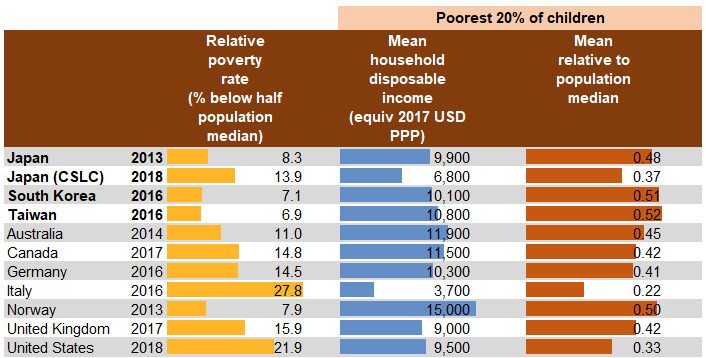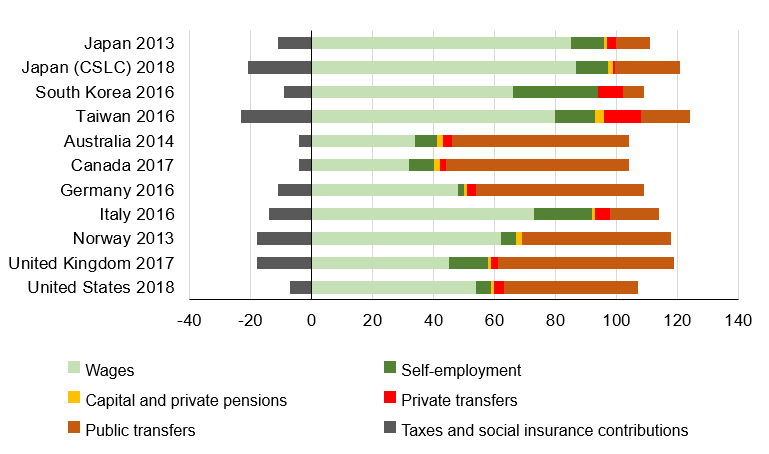Issue, No.23 (September 2022)
Explaining the child poverty outcomes of Japan, South Korea and Taiwan
(LIS WP840: Revised version forthcoming in Ku, Inhoe and Peter Saunders (eds) Poverty and Inequality in East Asia. Edward Elgar Publishing)
In Japan, South Korea and Taiwan, child poverty rates are relatively low, despite weak social protection for families with children. Why is this so?
In LIS Working Paper No.840 we compare child poverty patterns in these three societies with those in Western countries using data from the Luxembourg Income Study (LIS) Database and national datasets. We look at relative poverty rates and the incomes of the poorest one-fifth of children in each society.
Distinguishing them from the various models in Western welfare states, the welfare regimes of East Asia have in the past been described as ‘productivist’ or ‘developmental’. Under this model, government resources are directed to economic development rather than social expenditure, families are assumed to provide strong support for their members regardless of co-residence status, there are strong gender disparities in employment, and labour movements (trade unions) are weak. The key role of social insurance in these systems is to enhance productivity by supporting the workforce critical to economic development.
While there are differences between the three societies, all three have low levels of social transfers to disadvantaged families, and relative child poverty rates are low. Korea and Taiwan, in particular, have poverty rates significantly below those of most Western countries. While our preferred dataset for Japan shows a higher poverty rate than that used in previous cross-national research, it is still not high, and is near the Western average.
A large part of our explanation for these results stems from demographic patterns. Total fertility is low (especially in Korea and Taiwan), family size is small, parents are older and lone parent families uncommon. Controlling for these influences, Korea and Taiwan would have Western-typical poverty rates, and Japan one of the higher poverty rates in Western countries. In the light of low social transfers, high parental employment rates are also important for ensuring that poverty rates are not even higher.
To achieve these low poverty outcomes in these societies, access to parenthood is restricted, lone parent families have restricted options and employment is essentially a requirement of parenthood.
Poverty outcomes and income sources
Figure 1 shows several indicators of disadvantage for children and their families in Japan, Korea and Taiwan, as well as in seven comparison Western nations. Most of the results are from the Luxembourg Income Study (LIS) Database, but we also present results from the Japanese Comprehensive Survey of Living Conditions (CSLC) conducted by the Ministry of Health, Labor and Welfare. Compared to the LIS data (based on the Japan Household Panel Survey), it has a larger sample size and is a cross-sectional rather than panel survey – and so not subject to any attrition bias. The CLSC is the data used by the Japanese government for the calculation of poverty rates and thus our results using this data are more comparable to those used in the national poverty debate. For all these reasons, it is our preferred dataset and our discussion below focuses on results from it. It provides estimates of child poverty outcomes that are less favourable than those from the dataset used in LIS.
The first panel of the figure presents conventional relative poverty rates (see WP840 for details). This is supplemented by two measures for the poorest one-fifth of children, their mean (PPP adjusted) income, and this mean relative to the population median.
While the real incomes of the most disadvantaged Japanese children are lower than most of the Western countries (using the CSLC data), their relative poverty rate is similar to that in Canada, Germany and the UK. Korea and Taiwan have lower relative poverty rates – similar to that of Norway.
One explanation for this lies in the lower incomes of the elderly in the East Asian societies. If we were to calculate poverty relative to the median income of children, rather than of all families, the comparative poverty outcome in Japan in particular would be less favourable. Using this metric, Japan would have a poverty rate almost as high as the US (WP840, Table 1).
Even so, the poverty outcomes in all three societies are surprising given the low level of social transfers received by disadvantaged families with children. Figure 2 shows the sources of income for the most disadvantaged fifth of children in each of our societies. Standing out is the low share of income from social transfers in the East Asian societies; only 7 per cent in Korea up to 21 per cent in Japan. This is similar to what we find in Italy, but much lower than the other Western societies, where around half the household income of the poorest fifth of children comes from social transfers (44% in the US to 60% in Canada).
Figure 1: Child Poverty Indicators

Source: Luxembourg Income Study (LIS) Database except for Japan (CSLC).
Figure 2: Poorest fifth of children: Shares of household income from different sources

Source: Luxembourg Income Study (LIS) Database except for Japan (CSLC).
Explanations
Despite very low levels of social transfers, Korea and Taiwan have relative child poverty levels similar to those of societies like Norway with high welfare expenditures. Moreover, while our preferred data for Japan does not suggest the same anti-poverty success, it nonetheless has very low social transfers accompanied by child poverty outcomes similar to the average Western society. Why are these East Asian societies so successful in preventing child poverty?
In many respects, patterns in these East Asian societies are similar to those in Italy – our exemplar of the Mediterranean welfare state model. Among the poorest families, social transfers are low, the share of income from employment and especially self-employment is high, there are substantial private transfers and lone parent families are less common. But these East Asian societies do not experience the corresponding high child poverty rates and low real incomes of Italian families with children.
Even if we were to use the median income of (the families of) children as our poverty reference point, child poverty rates in Korea and Taiwan would still be at the lower end of the Western distribution. For Japan, child poverty relative to the child median income would be at the higher end, but still below that in Italy and the US.
The immediate driver of these favourable poverty outcomes is the amount of income other than social transfers – especially earnings – received by families with children. Among the poorest fifth of children in our East Asian societies, the share of income from earnings is around 100 per cent of disposable income, with the remaining income sources offset by taxes and social insurance contributions. This is much higher than in Western societies (other than Italy). Private income transfers are also important in East Asia. Correspondingly, employment levels are high in these three societies.
Lone parenthood is also less prevalent in these societies (along with Italy). However, even though lone parents tend to have higher poverty rates, this lower prevalence contributes little to the lower overall poverty rate in Korea and Taiwan. We undertake a counter-factual calculation where we apply the UK family type distribution to the three societies. This would tend to increase the overall poverty rate in Korea, Taiwan and Japan because the UK has more lone parents, and children in lone parent families are more likely to be poor. But the UK has fewer children in ‘other’ three-generation households, where poverty rates are high in Korea and Taiwan. This cancels out the lone-parent effect for these two societies. For Japan, on the other hand, poverty rates among lone mother families is particularly high, and so if they had the UK family type distribution their poverty rate would be almost as high as in the US.
As well as having different family structures, the three East Asian societies have very different fertility patterns to the Western model (though again, Italy is similar to the East Asian pattern). Fertility rates are much lower (well below replacement), family sizes are smaller and few parents are very young. Both the family size and parental age difference would be expected to reduce poverty rates (the former reduces consumption needs, while the latter is associated with higher earnings). If we control for family size and parental age, we find that the gap between Korean and Taiwanese versus Western poverty rates narrows significantly, and narrows further again if we control for family composition. Nonetheless, even after controlling for these factors, poverty rates in Korea and Taiwan remain at the lower end of Western estimates.
Japan has an observed poverty rate that is towards the middle of the Western range. However, we estimate that if family size, parental age and household composition were the same across countries, the Japanese rate would be the second-highest in our sample – slightly higher than both the US and UK, though still well below that of Italy.
Conclusion
These outcome differences provide a challenge to the concept of a single ‘East Asian’ welfare regime. Nonetheless, these three societies do share some common characteristics contributing to their relative poverty success: families with children have benefited from recent economic growth more than the older population, parents have high employment levels, lone parent families are uncommon (but multi-generation families are more common and have high poverty levels), and private between-household income transfers are more common.
In addition, the demographics of parenthood are very different in these societies and this explains much of the divergence in poverty outcomes. Nonetheless, without the high employment rates in these three societies, poverty would be much higher.
We speculate that the low levels of social transfers in these three societies are important drivers of these responses. In the absence of adequate social benefits, having a first child, or subsequent children, is economically risky. While the broader family can, and does, provide some support, it is not surprising that fertility is extremely low (especially in Korea and Taiwan) and that prospective parents are more likely to delay child rearing until their incomes are higher and have fewer children overall. Similarly, lone parenthood is infrequent and multi-generational families are common.
These parental demographic characteristics are part of the reason for the high employment levels of parents in these three East Asian societies. Selection into parenthood itself, where only people with strong earning potential become parents, might also be a factor, though we have not investigated this.
So, while these three societies have been able to maintain child poverty rates at low or modest rates – despite low levels of social protection – our results suggest that this has had other impacts on parental, and possibly child, well-being. Access to parenthood is restricted, private transfer support is necessary, lone parent families have restricted options and employment is essentially a requirement of parenthood. It is not surprising, therefore, that recent family policy discussions in all three societies have generally been developed through the lens of increasing fertility.
